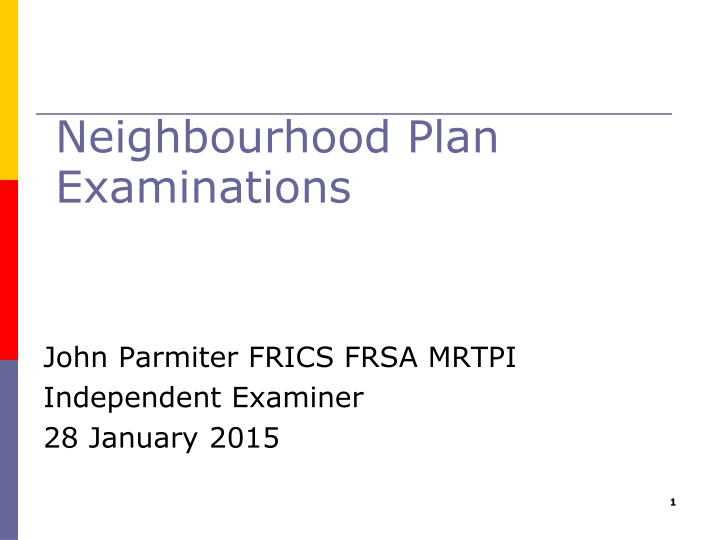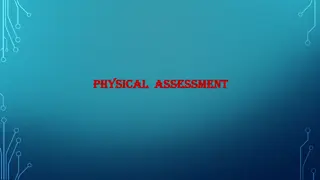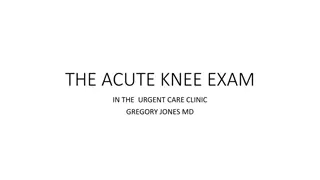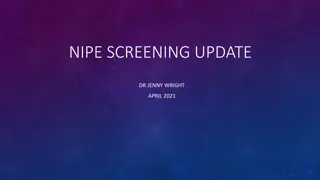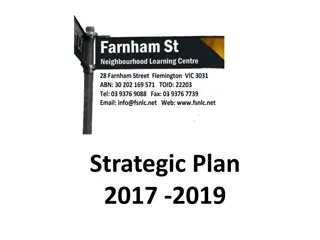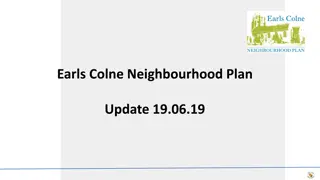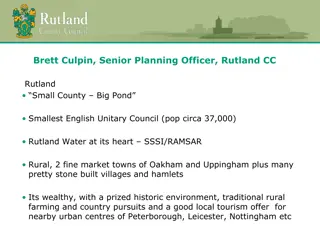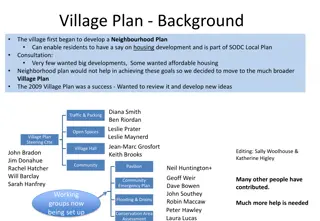Neighbourhood Plan Examination Process Overview
Understanding the Neighbourhood Plan Examination process involves appointing an independent examiner, selecting from available options, working collaboratively with the examiner, preparing for a public hearing, and managing representations effectively. Key aspects include appointment criteria, procurement methods, working arrangements, public hearing logistics, and handling participant interactions.
Download Presentation

Please find below an Image/Link to download the presentation.
The content on the website is provided AS IS for your information and personal use only. It may not be sold, licensed, or shared on other websites without obtaining consent from the author.If you encounter any issues during the download, it is possible that the publisher has removed the file from their server.
You are allowed to download the files provided on this website for personal or commercial use, subject to the condition that they are used lawfully. All files are the property of their respective owners.
The content on the website is provided AS IS for your information and personal use only. It may not be sold, licensed, or shared on other websites without obtaining consent from the author.
E N D
Presentation Transcript
Neighbourhood Plan Examinations John Parmiter FRICS FRSA MRTPI Independent Examiner 28 January 2015 1
Appointment LPA appoints but with agreement of the QB Source an examiner Timing: pre-submission consultation stage Brief: Give as much information as you can on the application form; are any specialist skills needed? What are the key issues in the Plan or Order? Site allocations? Be realistic about programme, duration, level of risk etc. 2
Selection NPIERS offers three Examiners (with CV) Standard day rate for all Procurement: make the process clear and transparent Process: If interviewing consider telephone or Skype Conflicts very important to flush out Independence absolutely essential Limit questions to the process of examination and the examiner s skills and experience it is important that the merits of the Plan are not discussed Try and provide feedback to the unsuccessful candidates Agree contractual arrangements PI issues include limit 3
Working with the Examiner Agree how LPA, QB and Examiner will work together Useful to have one point of contact The examination documents How long will the examination take? Is there a deadline to meet? Need for Public Hearing? How will you keep in touch? 4
Preparing for a Public Hearing Notice period for the hearing; publicity Venue keep it local Timing and duration Invitations to participants Issues to be discussed agenda and questions Site visits Note or record of the hearing Seating, access and other practical issues 5
A public hearing Tone its not a public inquiry Seating arrangements Refreshments/facilities/equipment etc. Social media Recording proceedings and note taking Press Examiner in charge managing expectations Managing the participants 7
Dealing with representations Process: Send copies to the examiner A summary sheet is a very helpful addition Dealing with late reps and Ad hoc reps Dealing with the public in general Reps for or at the hearing Considerations: Fairness, openness and transparency Basic Conditions and legal requirements Key recommendations: Plan and Referendum Overall: Light touch
Final comments It s about a light touch. Basic Conditions not soundness All on a learning curve including examiners! Consistency desirable between plans in same LPA area? Each examiner may have a different way of working Liaise and keep in touch with the QB/LPA Value of a public hearing Process does not stop at Examination but a sense of loss of control? Questions? 9
Thank you john@johnparmiter.com 10
